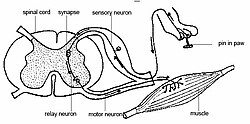Interneuron
| Interneuron | |
|---|---|

A spinal interneuron (relay neuron) forms part of a reflex arc
|
|
| Details | |
| Location | Nervous system |
| Identifiers | |
| MeSH | A08.663.358 |
| Code | TH H2.00.06.1.00058 |
| NeuroLex ID | Intrinsic neuron role |
| Dorlands /Elsevier |
i_10/ |
|
Anatomical terminology
[]
|
|
An interneuron (also called internuncial neuron, relay neuron, association neuron, connector neuron, intermediate neuron or local circuit neuron) is a broad class of neurons found in the human body. Interneurons create neural circuits, enabling communication between sensory or motor neurons and the central nervous system (CNS). They have been found to function in reflexes, neuronal oscillations, and neurogenesis in the adult mammalian brain.
Interneurons can be further broken down into two groups: local interneurons, and relay interneurons. Local interneurons have short axons and form circuits with nearby neurons to analyze small pieces of information. Relay interneurons have long axons and connect circuits of neurons in one region of the brain with those in other regions. The interaction between interneurons allow the brain to perform complex functions such as learning, and decision-making.
Unlike the peripheral nervous system (PNS), the central nervous system, including the brain, contains many interneurons. In the neocortex (making up about 80% of the human brain), approximately 20-30% of neurons are interneurons. Interneurons in the CNS are primarily inhibitory, and use the neurotransmitter GABA or glycine. However, excitatory interneurons using glutamate in the CNS also exist, as do interneurons releasing neuromodulators like acetylcholine.
In 2008, a nomenclature for the features of GABAergic cortical interneurons was proposed, called Petilla terminology.
...
Wikipedia
